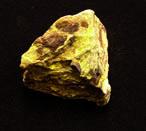TENORM: Uranium Mining Wastes
The mining of uranium ores by underground and by surface methods produces varying types and amounts of bulk waste material, including:
- Excavated top soil.
- Overburden
 OverburdenSoil and rocks that have been moved out of the way to get to ore are called "overburden." In areas where there are high concentrations of radionuclides in the rock, overburden may have some enhanced radioactivity, but not enough to mine and process.
OverburdenSoil and rocks that have been moved out of the way to get to ore are called "overburden." In areas where there are high concentrations of radionuclides in the rock, overburden may have some enhanced radioactivity, but not enough to mine and process. - Weakly uranium-enriched waste rock.
- Subgrade ores.
- Evaporation pond sludges and scales.
These materials typically contain radionuclides of radium, uranium and thorium.
EPA has developed detailed technical report from studies on uranium mining TENORM wastes and a database of known or potential mine locations.
Learn more about TENORM-producing industries and sources in the United States.
 Uranium Ore
Uranium Ore
History
Uranium has been used since Roman time as pigment in stained glass and glaze in ceramics. The modern uranium mining industry began in the 1940s primarily to produce uranium for weapons and later for nuclear fuel. EPA's Uranium Location Database, with information provided by other federal, state, and tribal agencies, includes 15,000 mine locations with known or potential uranium occurrence in 14 western states. View EPA's Uranium Location Database. Most of those locations are found in Colorado, Utah, New Mexico, Arizona, and Wyoming, with about 75 percent of those on federal and tribal lands. The majority of these sites were conventional (open pit and underground) mines. View information about and download the U.S. Department of Energy (DOE) 2014 Report to Congress related to Defense-Related Uranium Mines.
With the drop in market price of uranium beginning in the 1980s, U.S. producers turned increasingly to in-situ recovery operations to extract uranium from ore. By 2014, according to the Department of Energy's Energy Information Administration, there were only approximately six uranium mines operating in the U.S. and all but one of those were in-situ operations. View the U.S. Energy Information Administration’s Nuclear & Uranium website.
Regulation
Because U.S. laws do not classify mine overburden as a radioactive waste, its placement in radioactive waste disposal facilities is not required. The Atomic Energy Act does not require controls on uranium mining overburden. Neither the Nuclear Regulatory Commission (NRC), nor the Department of Energy (DOE) regulate the disposal of conventional (open pit and underground) mining wastes. Disposal regulations are primarily left to the states and the Bureau of Land Management. However, there are a variety of legal statutes to protect the public and the environment from exposures to both the hazardous and toxic characteristics of these wastes, which are classified as TENORM.
Under the authority of federal laws, individual states or federal land management agencies regulate environmental impacts utilizing clean water and clean air laws. These organizations also have a general authority to protect people and the environment from the adverse effects of mining activities.
In contrast, the uranium produced from the mined ore is directly regulated. Its possession, use, transport, etc. are regulated by both the NRC and its Agreement States. Regulation begins when the uranium is separated from the surrounding rock (beneficiated) or brought into the milling circuit for refining into uranium yellowcake![]() yellowcakeThe solid form of mixed uranium oxide, which is produced from uranium ore in the milling process. Its color can vary from yellow to orange to dark green. Yellowcake is processed into nuclear fuel.. The regulations also cover production from in-situ leaching operations. Learn about EPA's proposed updates to 40 CFR Part 192 regarding new ground water protection standards.
yellowcakeThe solid form of mixed uranium oxide, which is produced from uranium ore in the milling process. Its color can vary from yellow to orange to dark green. Yellowcake is processed into nuclear fuel.. The regulations also cover production from in-situ leaching operations. Learn about EPA's proposed updates to 40 CFR Part 192 regarding new ground water protection standards.
There are no exact totals of these types of waste in the United States. However there are estimates based on U.S. Geological Survey (USGS) data. According to USGS estimates, the approximately 4,000 open pit and underground mines in their database (also included in the Uranium Mines and Mills Location Database) generated about three billion metric tons. The volume of waste, including overburden, produced by open-pit mining is approximately 45 times greater than wastes produced from underground mining. Given the larger number of mine locations identified by EPA, the amount of waste rock is likely to be higher.
EPA’s Role
EPA is currently studying the extent and nature of the TENORM in mining wastes and its potential health effects.
View TENORM technical reports and resources.
Learn about EPA Region 9's work to address Uranium Contamination on the Navajo Nation.
